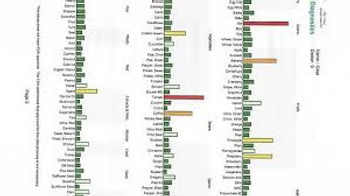Functional Medicine Testing
Below is an overview of the some of the functional medicine tests offered. Functional medicine testing provides an insight to how the body is functioning rather than being used to diagnose a disease or illness. This testing seeks to determine why the person has the problem in the first place, what function has been lost and what we can do to restore function.
Vitamin / Nutrient Deficiency | Heart Health | Prediabetes | Fitness Level Assessment | Bone Health
Food Allergies / Sensitivities | Female Hormone | Male Hormone | Adrenal Testing | Digestion
Spectracell Micronutrient Test
This test measures the function of 35 nutritional components including vitamins, antioxidants, minerals and amino acids within our white blood cells. The lab results include a report easily identifying deficiencies and supplementation recommendations.
Includes:

Vitamins:
-
Vitamin A
-
Vitamin B1
-
Vitamin B2
-
Vitamin B3
-
Vitamin B6
-
Vitamin B12
-
Biotin
-
Folate
-
Pantothenate
-
Vitamin C
-
Vitamin D
-
Vitamin K
Minerals:
-
Calcium
-
Magnesium
-
Manganese
-
Zinc
-
Copper
Amino Acids:
-
Asparagine
-
Glutamine
-
Serine
Fatty Acids:
-
Oleic Acid
Antioxidants:
-
Alpha Lipoic Acid
-
Coenzyme Q10
-
Cysteine
-
Glutathione
-
Selenium
-
Vitamin E
Carbohydrate Metabolism:
-
Chromium
-
Fructose Sensitivity
-
Glucose-Insulin Metabolism
Metabolites:
-
Choline
-
Inositol
-
Carnitine
SPECTROX for total antioxidant function
IMMUNIDEX for immune response score

Cardiometabolic Testing by Spectracell
Prediabetes Test
Lipoprotein particle testing to assess cardiovascular risk
It tests for the actual LDL particle count which gives your healthcare provider a more accurate assessment of cardiovascular risk especially in patients who have normal LDL values but low HDL and high triglycerides. With this test, patients with atherogenic profiles can begin to be treated before high cholesterol numbers from standard blood testing become apparent.
LPP Plus:
-
Lipoprotein Fractionation
-
Lipoprotein Particle Numbers
-
Total Cholesterol
-
HDL Cholesterol
-
LDL Cholesterol
-
Triglycerides
-
hs-CRP
-
Homocysteine
-
Apolipoprotein A-1
-
Apolipoprotein B
-
Lipoprotein (a)
-
Insulin
LPP Basic:
-
Lipoprotein Fractionation
-
Lipoprotein Particle Numbers
-
Total Cholesterol
-
HDL Cholesterol
-
LDL Cholesterol
-
Triglycerides
-
Lipoprotein (a)
This test measures the biomarkers that can identify your risk towards developing diabetes.
-
Insulin
-
Glucose
-
HemoglobinA1c
-
C-peptide
-
Adiponectin
-
Leptin
-
hs-CRP
-
Triglycerides
-
HDL Cholesterol
Functional Blood Chemistry Analysis

Routine blood work is analyzed through functional ranges to assess risk for disease before disease develops. The pathological range is used to diagnose disease. For example, levels above the pathological range for glucose is diabetes but levels outside the functional range for glucose and still within the pathological range may indicate insulin resistance and future risk for developing diabetes. In this scenario, preventative medicine can be practiced such as lifestyle, diet, nutrition, and other noninvasive therapies.

Heart Rate Variability Testing and Fitness Assessment
Fitness assessment is based on a simple 4-5 minute lying to standing test. This test provides a measurement of the level of physical fitness based on the level of heart rate variability (HRV). Heart rate variability is a physiological phenomenon in variation of the time intervals between heart beats. Assessment based on heart rate variability analysis is a way to accurately evaluate fitness and the overall functioning of the body. The assessment can be used to:
-
Obtain a baseline fitness level
-
Monitor progress of your fitness training program
-
Note any changes in the fitness condition
-
Immediately interpret test results
-
Evaluate any individual ranging from professional athletes to the elderly
The Fitness Score
Our fitness depends on the ability to mobilize the body's resources in response to physical stress.
The fitness score is a combination of Functional capacity and Adaptability levels.
Functional capacity is a fitness score component that reflects how well one's body functions as a whole system. It is
an indicator of general well-being, and may vary in response to stress and changes in lifestyle.
Adaptability is a measure of efficiency of the cardiovascular system in response to physical activity.
The “stronger” one's cardiovascular system, the higher is the level of adaptability. Adaptability can
significantly improve with the right exercise program as well as with diet.


FIT (Food Inflammation Test)
This test is used to identify delayed food sensitivities by measuring both IgG and complement together to determine the “problem” foods which then can be eliminated from the diet. The FIT test screens up to 132 of the most common foods and food additives. Knowing which foods you are sensitive to can be very helpful in improving a variety of symptoms that you may be experiencing such as headaches, digestive complaints, brain fog, etc.


Adrenal Stress Index
The adrenal stress index is a non-invasive way to help evaluate the effects of stress on your body. It can be used to:
-
Help identify possible causes of excessive fatigue
-
Identify underlying reasons for chronic infections including sinusitis and other recurrent respiratory infections
-
Identify possible reasons why you may have difficulty falling asleep or staying asleep
-
Monitor how your body deals with pain and inflammation
Bone Health Panel
The bone health panel provides an assessment of bone health utilizing a combination of non-invasive saliva and urine tests. It measures how fast bone is being lost and the hormone levels associated with maintaining bone density.
Female Hormone Panel
The cycling female hormone panel is a non-invasive test consisting of eleven saliva samples collected at specified times throughout the menstrual cycle. The test is most applicable to cycling women with any of the following conditions:
-
Weight gain
-
Functional infertility
-
Osteoporosis
-
Endometriosis and ovarian cysts
-
Fibroids and fibrocystic breasts
-
Increased risk of breast cancer
-
Recurrent cycle-related symptoms and irregularities, such as PMS, migraines, breast tenderness, emotional and cognitive issues, insomnia and spotting
Post- and Perimenopause Panels
The Postmenopausal Hormone Panels use accurate, noninvasive salivary testing to evaluate hormones that play a role in female reproductive function. These tests provide insight into factors that may contribute to common menopausal symptoms and are useful for monitoring hormone levels in women on bioidentical hormone replacement therapy. The Postmenopause Hormone Panel (PostM) uses a single saliva collection and is ideal for women who no longer have menses (> 1 year). The Perimenopause Hormone Panel (PeriM) uses two saliva samples collected about two weeks apart and is the preferred test for women experiencing early signs of menopause such as infrequent or unpredictable menses.
Male Hormone Panel
The male hormone panel uses non-invasive testing to assess hormone imbalances and deficiencies in the androgen (male) hormone pathway. The test is most applicable to men with any of the following conditions:
-
Decreased muscle mass and strength.
-
Decreased vigor or low energy
-
Decreased libido
-
Insomnia
-
Nervousness and depression
-
Hair loss

Small Intestinal Bacterial Overgrowth (SIBO) Breath Test
Small Intestinal Bacterial Overgrowth can be diagnosed by taking hydrogen or methane breath samples over a 3 hour period in the office or at home. SIBO is an of overgrowth of various types of bacteria that should normally be found in the large intestine and can cause symptoms of abdominal pain, bloating, gas and diarrhea. Once diagnosed, an appropiate treatment can be administered.



